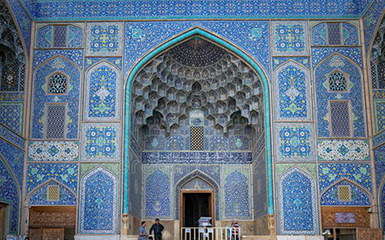Ardabil
Arg-e Bam
Abyaneh
Babak Castle
Behistun
Chogha Zanbil
Dasht-e Lut
Golestan Palace
Isfahan
Imam mosque
Kashan
Kharanaq
Mashhad
Masuleh
Meymand
Pasargadae
Naqsh-e jahan
Naqsh-e Rostam
Persepolis
Rayen Citadel
Saint Thaddeus
Saint Stepanos
Shiraz
Shushtar
Sultan Amir Ahmad
Tabriz
Takht-e Soleyman
Tehran
Tower of Silence
Yazd
Naqhsh-e Jahan Square also called Meidan-e Shah and, since the Islamic Revolution, Meidan-e Emam, is a square in the historic centre of the city of Isfahan, Iran. Built by Shah Abbas I in the early 17th century, it bears witness to the social and cultural life of Persia during the Safavid dynasty and was listed as a UNESCO World Heritage Site in 1979 as an important historical site.
The square forms an elongated rectangle 560 meters long and 160 meters wide and is aligned almost exactly in a north-south direction. At the time of its construction, it was the largest square in the world. Planned as a marketplace, court of law, playing field and fairground in equal measure, it is surrounded by important structures: the Shah Mosque to the South, the Ali Qapu Palace to the West, the Sheikh Lotfallah Mosque to the East and one of the gates of the Grand Bazaar of Isfahan on the North side. In this way, the square and the surrounding buildings form a cohesive ensemble that is intended to symbolize the connection between secular culture and the spiritual as well as trade and commerce.
Two mighty and richly decorated entrance portals rise up on the narrow sides of the square. To the south is the magnificent entrance gate to the king's mosque, which is called Masjed-e Emam, and to the north is the wide but comparatively simple entrance to the bazaar.
In the west is the Ali Qapu, the High Gate, it was the entrance to the Shah's garden palace and served as a viewing platform. Opposite it, to the east, the entrance portal of a prayer house, a smaller, more private royal mosque, the Masjed-e Sheikh Lotfollah, fits into the arcades.
Almost simultaneously with the completion of the square in 1601, the construction of the buildings around the square began, with only the Sublime Gate being able to fall back on an existing structure: a pavilion from the Timurid period, which was increased and expanded.
Today, the area is still the defining centre of the city and its cultural and social life. At the same time, it is one of the most important sights in Iran. The square is now dominated by formal, park-like green spaces and a huge pool with a fountain in the middle, the arcades serve as a promenade behind which shops, craft stalls, restaurants and tearooms invite visitors to visit.


